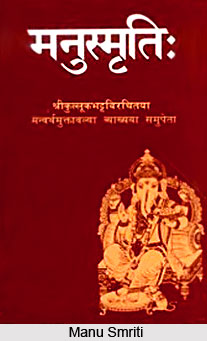 Women Rights in Manu Smriti reveal the efforts of the elite caste in restricting legal independence of the women in that period. The code prescribes that she should be completely subordinated to the will of the lord of the house. However, great respect is paid to the mother by her children. It was advocated that women must be made to feel their dependence on their husbands. However, if they are fond of worldly amusements they should be allowed to follow their own fondness.
Women Rights in Manu Smriti reveal the efforts of the elite caste in restricting legal independence of the women in that period. The code prescribes that she should be completely subordinated to the will of the lord of the house. However, great respect is paid to the mother by her children. It was advocated that women must be made to feel their dependence on their husbands. However, if they are fond of worldly amusements they should be allowed to follow their own fondness.
Laws of Manu are considered as anti-feminist in nature. These laws deprived woman of her religious rights and a spiritual life. The women who belonged to the caste of Shudras were not allowed to read the Vedas. It was even told that a woman could never attain heaven by her own merit. She could not perform a sacrifice on her own. Her only way to reach heaven was through implicit obedience to her husband. She was basically denied any kind of spiritual and intellectual nourishment. These laws elaborated the myth that all women were sinful and are prone to do evil activities. The want of a suitor alone is responsible for a woman`s chastity. Therefore it has been prescribed that she should be kept under constant vigilance. The best way to do it was to keep her occupied in the tasks of motherhood and domestic duties. Manu`s Code of Laws had an influence on the social attitude towards women.
Certain laws of Manu in respect to women are:
* "In childhood a female must be subject to her father, in youth to her husband, and when her lord is dead, to her sons; a woman must never be independent."
* "Women do not care for beauty, nor is their attention fixed on age; they give themselves to the handsome as well as to the ugly just for the fact that he is a man."
* "A husband should be worshiped as a God."
* "Even in the home nothing should be done by a child, a young or even an old woman independently."
* "A wife, a son, and a slave, these three are declared to have no property. The wealth which they earn is acquired for him to whom they belong."
* "Women must particularly be guarded against evil inclinations, however trifling they may appear to be; for, if they are not guarded, they will bring sorrow on both the families. Considering it the highest duty of all castes, even wealthy husbands must strive to guard their wives....lest the seed of others be sown on your soil."
* "It is the nature of women to seduce men in this world, for that reason the wise never remain unguarded in the company of female."
* "A wife cannot be dismissed from the marriage by a slave, separation or abdication."
"A man can leave a barren woman after eight years and one who only gives birth to daughters."



















